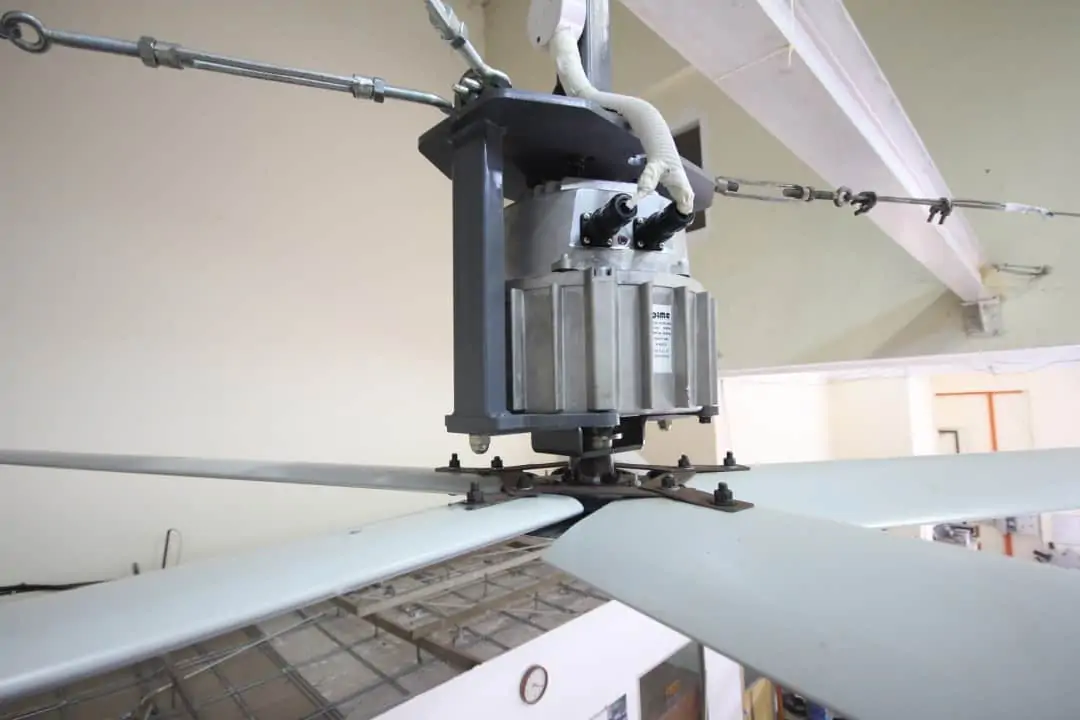https://suriagiantfan.com/wp-content/uploads/2024/05/IMG_1803.mov The largest and grandest mosque in the state of Terengganu is the Taman Ilmu…

3 Advantages of HVLS Fan Built-in Inverter
1) Loss of Power on the cable
Electric cables have resistance per foot, and the longer the cable, the greater the resistance. When a current flows through a cable, the current flowing through the resistance results in a decrease in voltage according to Ohm’s law, voltage = current x resistance. Therefore, the inverter cannot provide full power when the position of the inverter is away from the electric motor. Loss of efficiency up to 70% while the required speed cannot be achieved.
2) Reduction of Radio Frequency Interference
While we limit the consideration of possible causes of RFI to consumer electronics, the scenery is increasingly congested. From cell phones to microwaves, our love affair with electronics means the possible causes of RFI are evolving day by day.
That is why, for companies that produce products that rely on electronic circuits, RFI is an important factor in every stage of product development, from design to pre-compliance testing. Therefore, determine whether a product meets electromagnetic compatibility (EMC) requirements or not.
Because of the problems that RFI can cause, it is important to prevent it. In addition, the Federal Communications Commission (FCC) regulates emissions standards for EMCs, which are discussed by Title 47 of the Federal Code of Conduct (CFR), or 47CFR. Non-compliance with 47CFR can result in fines, which is why it is very important to conduct a pre-compliance test to determine whether or not a particular product complies.
Some possible causes of RFI include:
• Concentration of electronic devices in the spectrum
• Connections consist of electronic devices
• Poor enclosure design with low absorption loss
• In many cases, design flaws are the reason for RFI.
Biological effects can occur as a result of exposure to RF energy. The biological effects caused by tissue heating by RF energy are often referred to as “thermal” effects. It has been known for years that exposure to very high levels of RF radiation can be harmful due to the ability of RF energy to heat biological tissue quickly. This is the principle by which microwaves cook food. Exposure to very high RF intensities can result in biological tissue warming and an increase in body temperature. Tissue damage in humans can occur during exposure to high levels of RF due to the body’s inability to cope with or eliminate the excess heat that can be produced. Two parts of the body, the eyes and the testicles, are particularly vulnerable to RF heating due to the lack of blood flow available to remove excess heat load.
Call/Whatapp for More Information HVLS Fan : 0197362630
3) Reduction of Electromagnetic Interference.
What Is Electromagnetic Disorder (EMI) And How Does It Affect Us?
Electromagnetic interference, abbreviated EMI, is interference caused by electromagnetic interference that affects the performance of a device, transmission line, or system. It is also called radio frequency interference, or RFI when the interference is in the radio frequency spectrum.
We all face EMI in our daily lives. Common examples are:
• Interference with audio/video signals on radio / TV due to low altitude aircraft
• Noise on the microphone from a mobile phone handshake with a communication tower to process calls
• Welding machines or kitchen mixers/grinders produce unwanted noise on the radio
• In flight, especially during departure or landing, we are asked to turn off the mobile phone because EMI from the mobile phone is actively interfering with navigation signals.
EMI consists of two types, which are performed – in which there is a physical connection between the source and the circuit affected, and emitted – caused by induction. EMI sources experience rapidly changing and possibly natural currents such as lightning, solar flares, or man-made such as turning off or turning on heavy electrical loads such as motors, elevators, etc. EMI can disrupt, prevent, or cause the appliance to perform poorly or even cause damage.
In radio astronomical language, EMI is called radio frequency interference (RFI) and is a signal in the observed frequency path that originates from other than the source of the sky itself. In radio astronomy, the RFI level is much larger than the intended signal is a major obstacle.
Vulnerability to EMI and Analog amplification Analog amplitude or older, traditional technologies cannot distinguish between desired and unwanted signals and are therefore more susceptible to in-band EMI. Recent technologies such as Wi-Fi are more robust, using error correction technology to reduce the effects of EMI. All integrated circuits are potential EMI sources but are considered important only in relation to physically larger components such as printed circuit boards, heat sinks, connector cables, and others. Mitigation techniques include the use of surge holders or transzorbs (temporary absorbers), separator capacitors, and others.
Spectrum and frequency propagation techniques help analogue and digital communication systems to combat EMI. Other solutions such as diversity, directional antennas, etc., enable the selection of the desired signal selectively. Protecting with RF gaskets or a conductive copper tape is often the last option because of the additional cost.
RFI detection with software is a modern method of dealing with RFI in strips. It can detect disturbing signals in the time domain, frequency or frequency of time, and ensure that these signals are removed from further analysis of the observed data. This technique is useful for radio astronomy studies but is less effective for EMI than most man-made sources.
EMI is sometimes used for useful purposes as well, such as for modern warfare, where EMI is intentionally produced to cause the congestion of enemy radio networks to disable it for strategic advantage.
Rules to contain EMI
The International Special Committee for Radio Interference (CISPR) has created global standards that include recommended emissions and immunity limits. These standards lead to other regional and national standards such as the European Norm (EN). While there are additional costs incurred in some cases to provide an agreed immune system to electronic systems, adhering to these regulations improves the perceived quality for most applications in today’s environment.
https://www.linkedin.com/pulse/3-kelebihan-inverter-terbina-dalam-hvls-fan-khairil-anuar-muhammad




